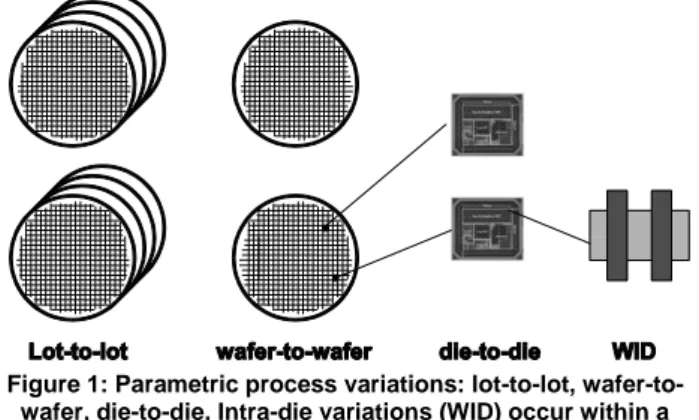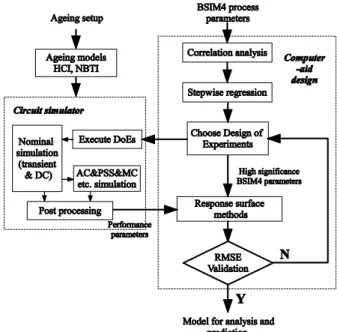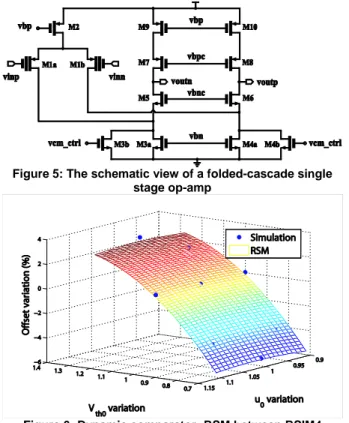HAL Id: hal-01246974
https://hal.archives-ouvertes.fr/hal-01246974
Submitted on 20 Dec 2015
HAL is a multi-disciplinary open access
archive for the deposit and dissemination of
sci-entific research documents, whether they are
pub-lished or not. The documents may come from
teaching and research institutions in France or
abroad, or from public or private research centers.
L’archive ouverte pluridisciplinaire HAL, est
destinée au dépôt et à la diffusion de documents
scientifiques de niveau recherche, publiés ou non,
émanant des établissements d’enseignement et de
recherche français ou étrangers, des laboratoires
publics ou privés.
Computer-aided reliability-aware approach for
analog/mixed integrated circuits and systems
Hao Cai, Hervé Petit, Jean-François Naviner
To cite this version:
Hao Cai, Hervé Petit, Jean-François Naviner. Computer-aided reliability-aware approach for
ana-log/mixed integrated circuits and systems.
Journees Nationales du Reseau Doctoral en
Micro-Nanoelectronique, Jun 2013, Grenoble, France. �hal-01246974�
Computer-aided reliability-aware approach for analog/mixed
integrated circuits and systems
Hao Cai, Hervé Petit, Jean-François Naviner
Institut Mines-Télécom, Télécom-Paristech, LTCI-CNRS-UMR 5141 46 rue Barrault,75634, Paris Cedex 13 – France
E-mail : firstname.lastname@telecom-paristech.fr
Résumé
The paper introduces the technology scaling induced reliability problems. Based on BSIM4 transistor model, nominal ageing simulation and statistical methods are integrated as an efficient computer-aided approach that applies to reliability analysis of analog/mixed circuits and systems. The ageing varied response surface modeling (RSM) is proposed to represent both ageing and process variations induced degradation. Dynamic comparator is used to verify the proposed method. Furthermore, it is discussed that the proposed method is competent for reliability study in Analog and Mixed-Signal (AMS) circuits and systems.
1. Introduction
The continuing scaling of CMOS technology brings the SoCs into new conditions. Integrated circuits and systems meet reliability challenges [1]. Reliability problems mainly include dynamic effects (i.e. temperature variations), spatial effects (i.e. manufacturing process variations) and temporal effects (i.e. ageing effects). These problems impact the ICs performance and their service lifetime. Traditionally, circuits/systems are often designed conservatively (e.g. leaving large design margins, worst case design) to guarantee reliability. However, these overdesign strategies are pessimistic.
AMS circuits/systems show a trend of high-integration and complexity in current nanometer technologies. Systems such as sigma-delta analog-to-digital converters (ADCs), RF frontends are constituted with many blocks (e.g., sensors, analog circuits, digital logic circuits, processors). Various blocks that appear on a chip with ultra scaled CMOS technology bring reliability bottlenecks. The development of proper reliability-aware approach is very essential.
In this paper, we present a computer-aided reliability approach for reliability simulation of analog/mixed ICs and systems. The rest of the paper is organized as follows. Section 2 presents different reliability problems. Section 3 illustrates our approach. In Section 4, a op-amp in 65nm CMOS technology is used to demonstrate the proposed method. The method is discussed with AMS/RF circuits/systems. Finally, conclusions are posed in Section 5.
Figure 1: Parametric process variations: lot-to-lot, wafer-to-wafer, die-to-die. Intra-die variations (WID) occur within a
die.
2. Previous work
2.1 Ageing effects and process variations
In this paper, Hot Carrier Injection (HCI) and Negative Bias Temperature Instability (NBTI) are considered as the main ageing effects. HCI emerges from the shrinking of transistor dimension and the electric field increasing in the channel. When HCI happens, the hot electrons overcome the potential barrier and inject into gate oxide due to high lateral electric field near the drain, which result transistor parameters shift (e.g. threshold voltage (Vth), mobility
(μn)) over time. For NBTI, when negative gate bias is
applied to PMOS, the transverse electric field is generated. The generation of the interface trap will cause an increase in Vthin PMOS transistor.
On the other hand, transistor parametric process variations can be divided into two main categories: physical variations and environmental variations [2]. As shown in Figure 1, physical variations exist during SoCs manufacturing phase, which can be further decomposed into: lot-to-lot, wafer-to-wafer, die-to-die and intra-die (within die, WID) variations. Environmental variations include the fluctuations in supply voltage, environment temperature and switching activity, which arise during the usage of ICs.
2.2 Reliability of analog/mixed circuits and systems
Reliability problems of AMS circuit/systems have been considered in many published work. In [3], a design for reliability method is proposed and developed for AMS/RF circuits. A digital controlled oscillator (DCO) has been studied. Ageing degradation can be improved by
applying design for reliability methods. In [4], a continuous-time (CT) second-order sigma delta modulator with return-to-zero (RZ) feedback (see Figure 2) is implemented. Reliability study on the building blocks shows that feedback loop is less reliable than loop filter. DAC is the most sensitive block.
Figure 2: The block diagram of a second order continuous time Sigma-Delta modulator. At circuit level, we have OTAs
in loop filter, comparator (quantizer), digital-to-analog converter (DAC) and clock phase generator.
3. The simulation method and framework
As shown in Figure 3, the co-evaluation flow begins with ageing model selection (HCI and NBTI). The schematic of designed circuit and the stress time are the input of the ageing simulation process [5][6]. With ageing degradation models, after extracting fresh netlist of designed circuits, a transient simulation is performed to generate an aged circuit netlist. On the branch of process variation, after filter out less important BSIM4 parameters, selected parameters are set up with a proper DoE mode. Ageing effect and process variation are evaluated by circuit simulator. Nominal simulation with transient and DC analysis is performed at transistor level. Other analysis such as AC, PSS and Monte-Carlo can be performed with saved aged circuit netlist (degradation information included). Simulation data processing is followed in order to plot response surface. RSMs are used to help designers to obtain intuitionistic reliability information at circuit design phase. For ageing-sensitive circuits, varied RSMs are used to estimate ageing and variability. Meanwhile, for ageing-immune circuits, a fixed RSM can supply variability information to designers [7]. Relevant statistics methods for BSIM4 parameters are presented in Table I.RSMs can display graphically the mathematical relationship between BSIM4 process parameters and circuit performance. It can help designers estimate varied and aged circuit performance efficiently. The key point of RSM is to select a proper tradeoff between estimation accuracy and computational cost. Sometimes, using linear model is hard to achieve adequate accuracy, quadratic model or even cubic model is required. The accuracy of RSMs can be evaluated by root-relative-square error (RMSE).
Table 1: Statistical methods and functions in general
Statistical methods Functions
Correlation analysis Screen out uncorrelated BSIM4 process parameters
Regression analysis Screen out less significant BSIM4 process parameters Design of
experiments (DoEs)
Simulate circuit performance with controlled experiments Response surface
Modeling (RSMs)
Map BSIM4 process parameters to performance parameters
Figure 3: The co-evaluation flow of ageing effects and process variations.
4. Evaluation and discussions
At circuit level, the proposed approach is evaluated with a dynamic comparator (see Figure 4) and a folded-cascade single stage op-amp (see Figure 5), both are with 65nm CMOS technology. Reliability simulation of HCI and NBTI effects is performed with ELDO simulator [8] (maximum ageing time = 20 years). The comparator shows immunity to HCI and NBTI effects. For process variation, the process induced variation in offset voltage is shown in Figure 6. Comparing to Monte-Carlo (MC) process variation analysis, better computational efficiency is achieved. This method can help designers know the detailed variation of certain parameters (i.e., Vth0, u0) at physical level. Figure 7
shows the RSM in op-amp which related Vth0 and Tox
(oxide thickness) to DC gain.
Figure 4: The schematic view of the dynamic comparator
With hierarchical behavioral modeling and bottom-up approach, this method can be extended to AMS circuits/systems. Behavioral modeling is applied to extract circuit non-ideal effects of each building block and then simulate the performance at the system level. Bottom-up approach is to model a system with an ascending order. Starting from the low-level (e.g. physical level), individual devices in the system are designed in detail and then linked to high level, until the
Figure 5: The schematic view of a folded-cascade single stage op-amp
Figure 6: Dynamic comparator: RSM between BSIM4 parameters and circuit performance
Figure 7: Op-amp: RSM between BSIM4 parameters and circuit performance
high-level system design is finished. Reliability information in Figure 6 and 7 can be propagated to the system level. The comparator and op-amp are behavioral simulated in a CT sigma delta modulator. The performance is simulated by sigma-delta toolbox [9]. Another RSM (see Figure 8) is plotted between
Figure 8: RSM reflects process parameter to ΣΔ modulator performance (SQNR)
physical level and system level. We find that the variations of tox influences system performance. A 8%
shift of tox can degrade SQNR from 60.5 dB (ideal case)
to 43 dB.
In the view of computation efficiency, it costs 17 runs of circuit level simulation (8 runs to find critical parameters, 9 runs with DoE). With this proposed methodology, in total it takes 45 minutes to get reliability performance (process variation and time dependent ageing degradation) of the designed ΣΔ modulator.
5. Conclusions
In this paper, reliability problems have been studied in AMS integrated circuits and systems. A reliability aware simulation method has been proposed and verified in 65nm CMOS circuit. RSM is used to display graphically the reflection from BSIM4 parameters to circuit performance. Reliability simulation methods for AMS/RF systems have been discussed. It can help designers get the process variation and ageing information in an early stage. Thus reliability information can be provided in an early stage of design loop. Efficient computation is achieved to help designers know detailed variation of critical process parameters.
6. Acknowledgments
This work is supported by RELY Catrene Research Project.
Références
[1]“International technology roadmap for semiconductors (ITRS)”, http://www.itrs.net/Links/ 2009ITRS/Home2009.htm, 2009
[2] C. Forzan and D. Pandini, “Statistical static timing analysis: A survey”, Integration, the VLSI Journal, vol.42, no. 3, pp 409-435, 2009
[3] P. Ferreira, H. Petit, and J.-F. Naviner, “AMS and RF design for reliability methodology”, Proc. IEEE ISCAS, pp. 3657–3660, 2010
[4] H. Cai, H. Petit, and J.-F. Naviner, “Reliability aware design of low power continuous-time sigma-delta modulator”, Microelectronics Reliability Journal, vol. 51, no.9-11, pp. 1449–1453, 2011 [5] H. Cai, H. Petit, and J.-F. Naviner, “A Hierarchical
Reliability Simulation Methodology for AMS Integrated Circuits and Systems”, Journal of Low Power Electronics, vol. 8, no.5, pp. 697–705, 2012 [6] H. Cai, H. Petit, and J.-F. Naviner, “A statistical
method for transistor ageing and process variation applied to reliability simulation”, 3rd European Workshop on CMOS variability, pp. 49–52, 2012. [7] H. Cai, H. Petit, and J.-F. Naviner, “A fast
reliability-aware approach for analogue integrated circuits based on Pareto fronts”, IEEE 11th New Circuits and Systems Conference, pp. 1–4, 2013. [8] Mentor Graphics, ''Eldo user manual,'' 1999
[9] Schreier R. The Delta-Sigma Toolbox Version 7.1, Available:http://www.mathworks.com/matlabcentra l/fileexchange,Dec. 2004.


